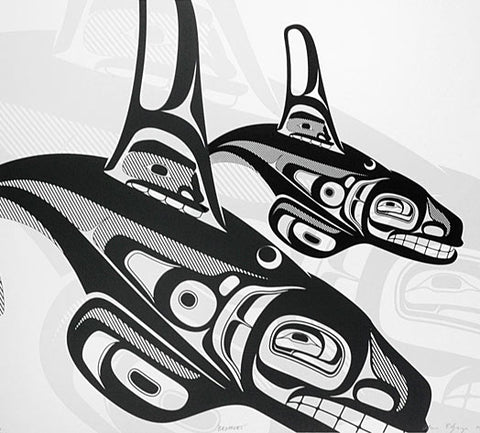Here at Native Art Prints, we sell a variety of graphic works. The act of printing consists of transferring ink to any surface by means of mechanical pressure. This is a general definition, but it applies to the silkscreen, giclee, lithograph, and digital prints that we carry. Screenprinting became an established art form within the Northwest Coast Native market in the late 1970s as institutions such as the Gitanmaax School of Northwest Coast Indian Art and Emily Carr University began promoting printmaking courses to the First Nations community. Artists who are now considered to be masters in the field - such as Robert Davidson, Beau Dick, Joe David, and Lyle Wilson - were among the first to begin experimenting with prints in the late 1970s and early 1980s.

Alano Edzerza's Brothers Giclée Print
We have included some general printmaking terms that are regularly used within the Northwest Coast Native art market below:
Limited Edition Print - Any print that is signed and numbered
Open Edition Print - A print that is not numbered, or "limited", in its production. Open edition prints may be signed, but the number of them produced is often unknown
Giclée Print - This term is derived from the French verb gicler meaning "to squirt". In printmaking, this term is used to describe a fine art digital printing process combining pigment based inks with high quality paper or treated canvas. Giclées in the Northwest Coast Native art market are often limited edition
Silkscreen Print - Also known as a "serigraph", this type of print is made through a stencil method of printmaking in which a design is imposed on a screen of silk or other fine mesh, with blank areas coated with an impermeable substance, and then ink forced through the mesh onto the printing surface
Lithograph - A type of print that requires no etching or stencils but is formed through the process of printing from a plane surface (such as a smooth stone or metal plate) on which the image to be printed is ink-receptive and the blank area ink-repellent. This process results in a high level of detail and can produce works that appear to be hand-drawn or sketched
AP Print - Any print designated as an "artist proof". Artist Proofs are produced at the same time as a limited edition run and are usually 10% the size of the limited edition run from which they originate. AP prints are often given to the artist for personal use, but it is common for these to enter the market as well. They usually carry the same value as limited edition prints, but some people consider them to be more valuable
Printer's Proof - Also known as a "proof print" or "PP", these are small and often numbered editions produced before a large limited edition printing to check quality and design. These are often kept by the printing house, but are occasionally given to the artist
Remarque - A personalized drawing or symbol on a run of prints. Included as a special edition to the title, date, and number of a print, the remarque often adds value to a work
